Piezoelectric Ceramics with High d33 Constants and Their Application to Film Speakers
Abstract
:1. Introduction
2. Methods
2.1. Preparation of the Piezoelectric Materials
2.2. Preparation of Multilayer Ceramics
2.3. Fabrication of the Piezoelectric Speaker
3. Results and Discussion
4. Conclusions
Author Contributions
Funding
Institutional Review Board Statement
Informed Consent Statement
Data Availability Statement
Conflicts of Interest
References
- Han, J.S.; Gal, C.W.; Park, J.M.; Park, S.J. Powder injection molding of PNN-PMN-PZN doped low temperature sintering PZT ceramics. J. Manuf. Process. 2017, 28, 235–242. [Google Scholar] [CrossRef]
- Kweon, S.Y.; Lee, K.S.; Park, Y.M.; Yoon, M.S. Low-temperature sintering of (1−x) Pb (Zr0.53Ti0.47) O3–xBYO3 ceramics with nano-powder for piezo-speaker. Jpn. J. Appl. Phys. 2019, 58, 051008. [Google Scholar] [CrossRef]
- Gao, R.; Chu, X.; Huan, Y.; Sun, Y.; Liu, J.; Wang, X.; Li, L. A study on (K, Na) NbO3 based multilayer piezoelectric ceramics micro speaker. Smart Mater. Struct. 2014, 23, 105018. [Google Scholar] [CrossRef]
- Yi, S.; Yoon, M.; Ur, S. Piezoelectric microspeakers with high compressive ZnO film and floating electrode. J. Electroceram. 2009, 23, 295. [Google Scholar] [CrossRef]
- Kim, H.J.; Yang, W.S.; No, K. Effects of an elastic mass on frequency response characteristics of an ultra-thin piezoelectric micro-acoustic actuator. IEEE Trans. Ultrason. Ferroelectr. Freq. Control 2013, 60, 1587–1594. [Google Scholar] [CrossRef]
- Lee, M.-S.; Yun, J.-S.; Park, W.I.; Hong, Y.-W.; Paik, J.H.; Cho, J.H.; Park, Y.-H.; Jeong, Y.-H. Characteristics and fabrication of multi-layered piezoelectric ceramic actuators for speaker application. J. Korean Inst. Electr. Electron. Mater. Eng. 2016, 29, 601–607. [Google Scholar] [CrossRef] [Green Version]
- Horchidan, N.; Ciomaga, C.E.; Frunza, R.C.; Capiani, C.; Galassi, C.; Mitoseriu, L. A comparative study of hard/soft PZT-based ceramic composites. Ceram. Int. 2016, 42, 9125–9132. [Google Scholar] [CrossRef]
- Yuan, D.; Yang, Y.; Hu, Q.; Wang, Y. Structures and properties of Pb (Zr0.5Ti0.5) O3-Pb (Zn1/3Nb2/3) O3-Pb (Ni1/3Nb2/3) O3 ceramics for energy harvesting devices. J. Am. Ceram. Soc. 2014, 97, 3999–4004. [Google Scholar] [CrossRef]
- Huang, Y.-H.; Ma, C.-C.; Chao, C.-K. High-frequency resonant characteristics of triple-layered piezoceramic bimorphs determined using experimental measurements and theoretical analysis. IEEE Trans. Ultrason. Ferroelectr. Freq. Control 2012, 59, 1219–1232. [Google Scholar] [CrossRef]
- Li, H.-L.; Zhang, Y.; Zhou, J.-J.; Zhang, X.-W.; Liu, H.; Fang, J.-Z. Phase structure and electrical properties of xPZN-(1-x) PZT piezoceramics near the tetragonal/rhombohedral phase boundary. Ceram. Int. 2015, 41, 4822–4828. [Google Scholar] [CrossRef]
- Nie, R.; Zhang, Q.; Yue, Y.; Liu, H.; Chen, Y.; Chen, Q.; Zhu, J.; Yu, P.; Xiao, D. Phase structure-electrical property relationships in Pb (Ni1/3Nb2/3) O3-Pb (Zr, Ti) O3-based ceramics. J. Appl. Phys. 2016, 119, 124111. [Google Scholar] [CrossRef]
- Stevenson, T.; Martin, D.G.; Cowin, P.I.; Blumfield, A.; Bell, A.J.; Comyn, T.P.; Weaver, P.M. Piezoelectric materials for high temperature transducers and actuators. J. Mater. Sci. Mater. Electron. 2015, 26, 9256–9267. [Google Scholar] [CrossRef] [Green Version]
- Fan, K.-K.; Wang, Y.-P.; Yang, Y. Co-firing of PZT–PMS–PZN/Ag multilayer actuator prepared by tape-casting method. Energy Harvest. Syst. 2015, 2, 113–117. [Google Scholar] [CrossRef]
- Hayashi, H.; Kawada, S.; Kimura, M.; Nakai, Y.; Tabata, T.; Shiratsuyu, K.; Nada, K.; Takagi, H. Reliability of nickel inner electrode lead-free multilayer piezoelectric ceramics. Jpn. J. Appl. Phys. 2012, 51, 09LD01. [Google Scholar] [CrossRef]
- Ngamjarurojana, A.; Ural, S.; Park, S.H.; Ananta, S.; Yimnirun, R.; Uchino, K. Piezoelectric properties of low temperature sintering in Pb (Zr, Ti) O3-Pb (Zn, Ni)1/3Nb2/3O3 ceramics for piezoelectric transformer applications. Ceram. Int. 2008, 34, 705–708. [Google Scholar] [CrossRef]
- Yoo, J.; Kim, Y.; Cho, H.; Jeong, Y.-H. High piezoelectric d31 coefficient and high Tc in PMW-PNN-PZT ceramics sintered at low temperature. Sens. Actuators A 2017, 255, 160–165. [Google Scholar] [CrossRef]
- Fan, G.F.; Shi, M.B.; Lu, W.Z.; Wang, Y.Q.; Liang, F. Effects of Li2CO3 and Sm2O3 additives on low-temperature sintering and piezoelectric properties of PZN-PZT ceramics. J. Eur. Ceram. Soc. 2014, 34, 23–28. [Google Scholar] [CrossRef]
- Ouchi, T.; Ohga, J.; Takei, T.; Moriyama, N. Wideband piezoelectric rectangular loudspeaker using a tuck shape PVDF bimorph. IEEE Trans. Dielectr. Electr. Insul. 2010, 17, 1074–1078. [Google Scholar] [CrossRef]
- Kwak, J.H.; Hur, S. Enhanced Performance of PVDF Piezoelectric Speaker Using PVDF/ZnO Nanopillar Composites. J. Sens. Sci. Technol. 2016, 25, 447–452. [Google Scholar] [CrossRef] [Green Version]
- Vittayakorn, N.; Puchmark, C.; Rujijanagul, G.; Tan, X.; Cann, D.P. Piezoelectric properties of (1-x) Pb (Zr1/2Ti1/2) O3-xPb (Zn1/3Nb2/3) O3 ceramics prepared by the columbite-(wolframite) precursor method. Curr. Appl. Phys. 2006, 6, 303–306. [Google Scholar] [CrossRef]
- Chao, X.; Yang, L.; Pan, H.; Yang, Z. Fabrication, temperature stability and characteristics of Pb (ZrxTiy) O3-Pb (Zn1/3Nb2/3) O3-Pb (Ni1/3Nb2/3) O3 piezoelectric ceramics bimorph. Ceram. Int. 2012, 38, 3377–3382. [Google Scholar] [CrossRef]
- Kim, S.W.; Jeong, Y.J.; Lee, H.C. Effects of Zn/Ni ratio and doping material on piezoelectric characteristics of Pb((Zn, Ni)1/3Nb2/3)O3–Pb(Zr, Ti)O3 ceramics. Sci. Adv. Mater. 2020, 12, 237–243. [Google Scholar] [CrossRef]
- Chure, M.C.; Chen, P.C.; Wu, L.; Chen, B.H.; Wu, K.K. Influence of poling conditions on the characteristics of PZT ceramics. Adv. Mater. Res. 2011, 284–286, 1375–1380. [Google Scholar] [CrossRef]
- Choi, J.J.; Lee, J.H.; Hahn, B.D.; Yoon, W.H.; Park, D.S. Co-firing of PZN-PZT/Ag multilayer actuator prepared by tape-casting method. Mater. Res. Bull. 2008, 43, 483–490. [Google Scholar] [CrossRef]
- Qin, L.; Sun, Y.; Wang, Q.M.; Zhong, Y.; Ou, M.; Jiang, Z.; Tian, W. Fabrication and characterization of thick-film piezoelectric lead zirconate titanate ceramic resonators by tape-casting. IEEE Trans. Ultrason. Ferroelectr. Freq. Control 2012, 59, 2803–2812. [Google Scholar] [CrossRef]
- Peng, G.; Chen, C.; Zhang, J.; Zheng, D.; Hu, S.; Zhang, H. Effects of PNN/PZT ratios on phase structure, electric properties and relaxation behavior of PZN–PNN–PZT ceramics. J. Mater. Sci. Mater. Electron. 2016, 27, 3145–3151. [Google Scholar] [CrossRef]
- Zhang, Y.; Zhu, X.; Zhu, J.; Zeng, X.; Feng, X.; Liao, J. Composition design, phase transitions and electrical properties of Sr2+-substituted xPZN-0.1PNN-(0.9-x) PZT piezoelectric ceramics. Ceram. Int. 2016, 42, 4080–4089. [Google Scholar] [CrossRef]
- Zheng, M.; Hou, Y.; Zhu, M.; Zhang, M.; Yan, H. Comparative study of microstructure, electric properties and conductivity for NiO and PNN modified Pb (Zn1/3Nb2/3) O3-PbZrO3-PbTiO3 ceramics. Mater. Res. Bull. 2014, 51, 426–431. [Google Scholar] [CrossRef]
- Choi, J.S.; Lee, C.H.; Shin, H.S.; Yeo, D.H.; Lee, J.H. The effects of PZT ratio and Sr doping on the piezoelectric properties in PZN-PNN-PZT. J. Korean Inst. Electr. Electron. Mater. Eng. 2018, 31, 19–23. [Google Scholar] [CrossRef]
- Pramanik, R.; Sahukar, M.K.; Mohan, Y.; Praveenkumar, B.; Sangawar, S.R.; Arockiarajan, A. Effect of grain size on piezoelectric, ferroelectric and dielectric properties of PMN-PT ceramics. Ceram. Int. 2019, 45, 5731–5742. [Google Scholar] [CrossRef]
- Zheng, M.; Hou, Y.; Zhu, M.; Zhang, M.; Yan, H. Shift of morphotropic phase boundary in high-performance fine-grained PZN-PZT ceramics. J. Eur. Ceram. Soc. 2014, 34, 2275–2283. [Google Scholar] [CrossRef]
- Zheng, M.-P.; Hou, Y.-D.; Ge, H.-Y.; Zhu, M.-K.; Yan, H. Effect of NiO additive on microstructure, mechanical behavior and electrical properties of 0.2PZN-0.8PZT ceramics. J. Eur. Ceram. Soc. 2013, 33, 1447–1456. [Google Scholar] [CrossRef]
- Wagner, S.; Kahraman, D.; Kungl, H.; Hoffmann, M.J. Effect of temperature on grain size, phase composition, and electrical properties in the relaxor-ferroelectric-system Pb (Ni1/3Nb2/3) O3-Pb (Zr, Ti) O3. J. Appl. Phys. 2005, 98, 024102. [Google Scholar] [CrossRef]
- Bernard-Granger, G.; Guizard, C. New relationships between relative density and grain size during solid-state sintering of ceramic powders. Acta Mater. 2008, 56, 6273–6282. [Google Scholar] [CrossRef]
- Yang, A.K.; Wang, C.A.; Guo, R.; Huang, Y.; Nan, C.W. Effects of sintering behavior on microstructure and piezoelectric properties of porous PZT ceramics. Ceram. Int. 2010, 36, 549–554. [Google Scholar] [CrossRef]
- Gao, F.; Cheng, L.-H.; Hong, R.-Z.; Liu, J.; Wang, C.-J.; Tian, C. Crystal structure and piezoelectric properties of xPb (Mn1/3Nb2/3) O3-(0.2-x) Pb (Zn1/3Nb2/3) O3-0.8Pb (Zr0.52Ti0.48) O3 ceramics. Ceram. Int. 2009, 35, 1719–1723. [Google Scholar] [CrossRef]
- Zheng, M.; Hou, Y.; Fu, J.; Fan, X.; Zhu, M.; Yan, H. Effects of cobalt doping on the microstructure, complex impedance and activation energy in 0.2PZN-0.8PZT ceramics. Mater. Chem. Phys. 2013, 138, 358–365. [Google Scholar] [CrossRef]
- Yue, Y.; Zhang, Q.; Nie, R.; Yu, P.; Chen, Q.; Liu, H.; Zhu, J.; Xiao, D.; Song, H. Influence of sintering temperature on phase structure and electrical properties of 0.55Pb (Ni1/3Nb2/3) O3–0.45Pb (Zr0.3Ti0.7) O3 ceramics. Mater. Res. Bull. 2017, 92, 123–128. [Google Scholar] [CrossRef]
- German, R.M.; Suri, P.; Park, S.J. Review: Liquid phase sintering. J. Mater. Sci. 2009, 44, 1–39. [Google Scholar] [CrossRef] [Green Version]
- Hou, Y.-D.; Chang, L.-M.; Zhu, M.-K.; Song, X.-M.; Yan, H. Effect of Li2CO3 addition on the dielectric and piezoelectric responses in the low-temperature sintered 0.5PZN-0.5PZT systems. J. Appl. Phys. 2007, 102, 084507. [Google Scholar] [CrossRef]
- Donnelly, N.J.; Shrout, T.R.; Randall, C.A. The role of Li2CO3 and PbO in the low-temperature sintering of Sr, K, Nb (SKN)-doped PZT. J. Am. Ceram. Soc. 2009, 92, 1203–1207. [Google Scholar] [CrossRef]
- Vuong, L.D.; Gio, P.D. Effect of Li2CO3 Addition on the Sintering Behavior and Physical Properties of PZT-PZN-PMNN Ceramics. Int. J. Mater. Sci. Appl. 2013, 2, 89–93. [Google Scholar] [CrossRef] [Green Version]
- Zhang, Q.; Yue, Y.; Nie, R.; Liu, H.; Chen, Q.; Yu, P.; Zhu, J.; Xiao, D. Achieving both high d33 and high TC in low-temperature sintering Pb (Ni1/3Nb2/3) O3–Pb (Mg1/2W1/2) O3–Pb (Zr0.5Ti0.5) O3 ceramics using Li2CO3. Mater. Res. Bull. 2017, 85, 96–103. [Google Scholar] [CrossRef]
- Donnelly, N.J.; Shrout, T.R.; Randall, C.A. Properties of (1−x) PZT-xSKN ceramics sintered at low temperature using Li2CO3. J. Am. Ceram. Soc. 2008, 91, 2182–2188. [Google Scholar] [CrossRef]
- Hur, J.; Kim, J.-H.; Lee, T.-G.; Seo, I.-T.; Kim, D.-H.; Nahm, S.; Kang, C.Y. Structural and piezoelectric properties of (1-x) Pb (Zr1-yTiy) O3-xPb (Zn0.4Ni0.6)1/3Nb2/3O3 ceramics near triple point. J. Am. Ceram. Soc. 2015, 98, 2887–2893. [Google Scholar] [CrossRef]
- Zeng, J.; Zhao, K.; Shi, X.; Ruan, X.; Zheng, L.; Li, G. Large strain induced by the alignment of defect dipoles in (Bi3+, Fe3+) co-doped Pb (Zr, Ti) O3 ceramics. Scr. Mater. 2018, 142, 20–22. [Google Scholar] [CrossRef]
- Yuan, S.; Huang, S.; Chu, X.; Gao, R. Optimization methods for acoustic performance of piezoelectric panel loudspeaker. In Proceedings of the 2011 International Conference on Electronic and Mechanical Engineering and Information Technology (EMEIT 2011), Harbin, China, 12–14 August 2011; pp. 332–337. [Google Scholar] [CrossRef]
- Huang, S.; Yang, Y.; Liu, S.; Chu, X. A large-diaphragm piezoelectric panel loudspeaker and its acoustic frequency response simulation method. Appl. Acoust. 2017, 125, 176–183. [Google Scholar] [CrossRef]
- Svec, J.G.; Granqvist, S. Tutorial and Guidelines on Measurement of Sound Pressure Level in Voice and Speech. J. Speech Lang. Hear. Res. 2018, 61, 441–461. [Google Scholar] [CrossRef]
- Kim, H.J.; Yang, W.S.; No, K. Improvement of low-frequency characteristics of piezoelectric speakers based on acoustic diaphragms. IEEE Trans. Ultrason. Ferroelectr. Freq. Control 2012, 59, 2027–2035. [Google Scholar] [CrossRef] [PubMed]
- Lucas, I.; del Real, R.P.; Michelena, M.D.; de Manuel, V.; Duch, M.; Esteve, J.; Plaza, J.A. Resonance frequency dependence on out-of-plane forces for square silicon membranes: Applications to a MEMS gradiometer. Sens. Actuators A 2010, 163, 75–81. [Google Scholar] [CrossRef] [Green Version]
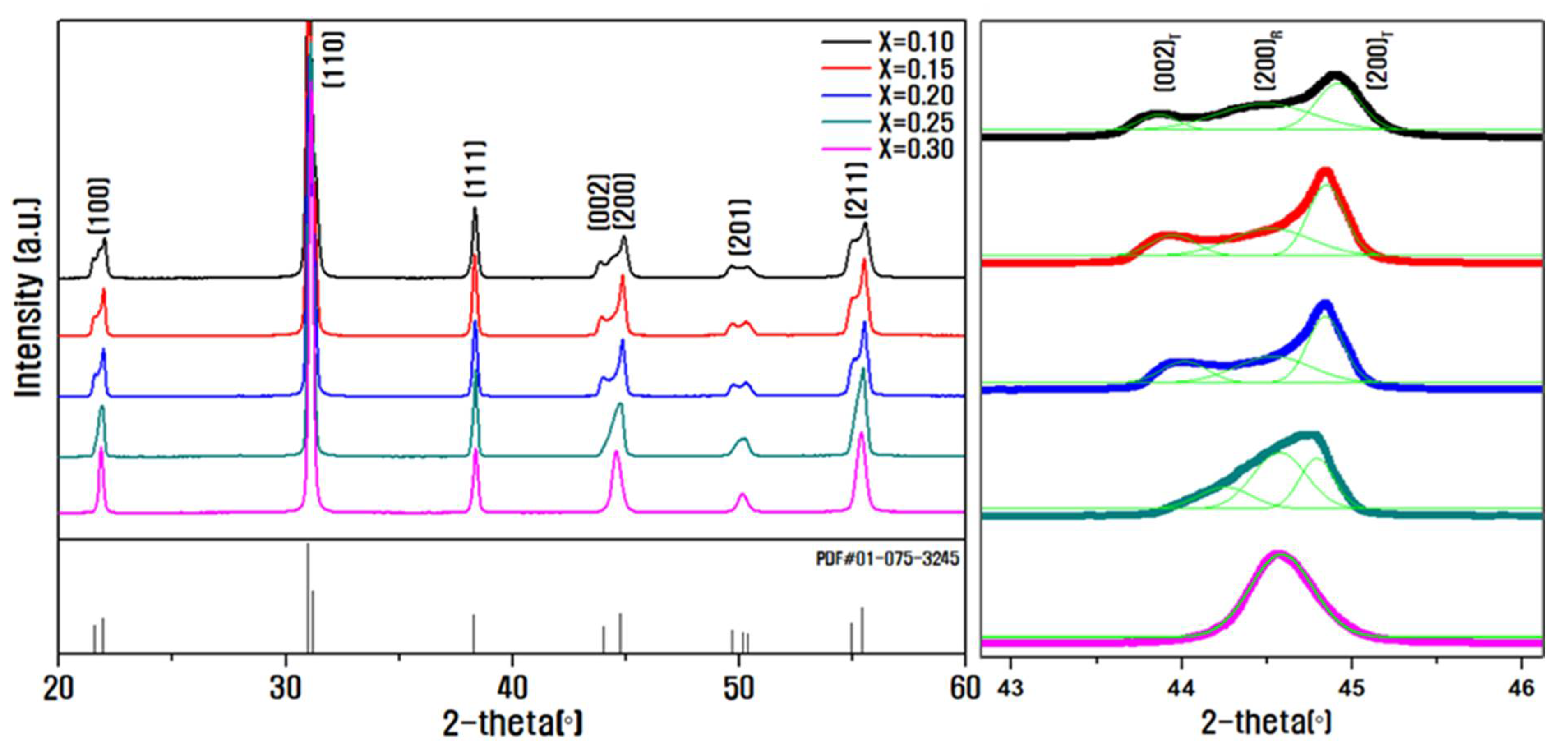
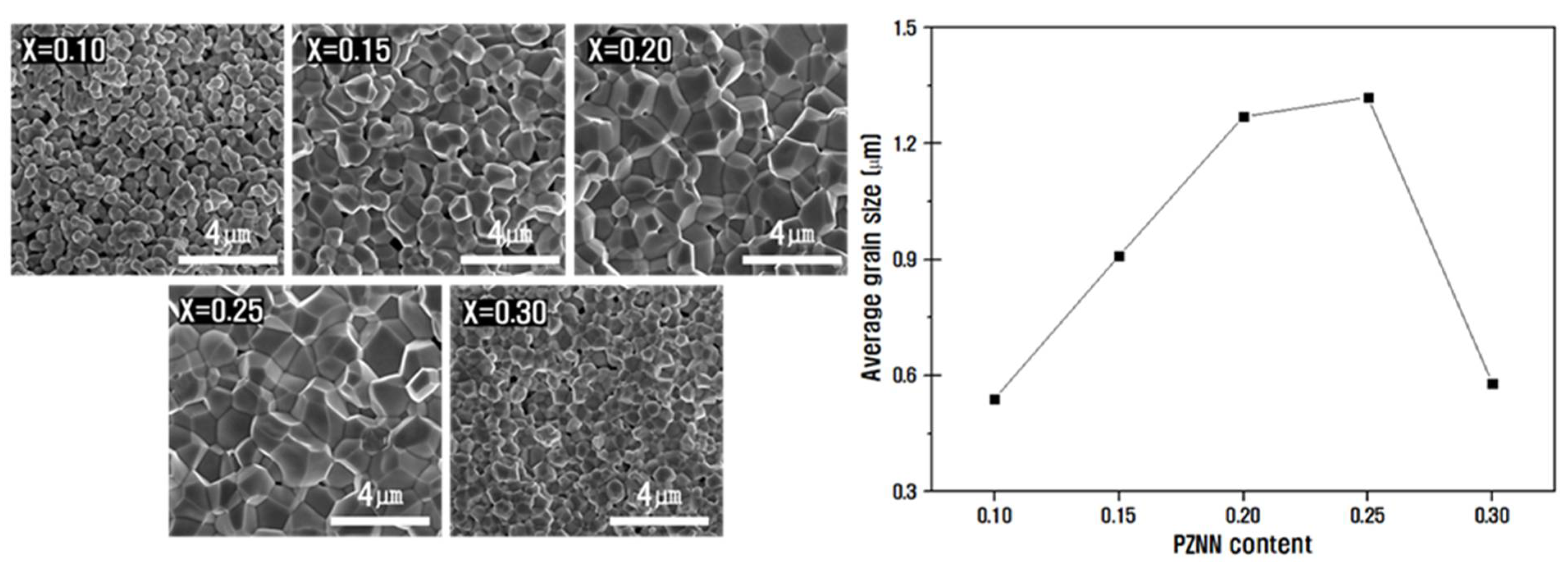
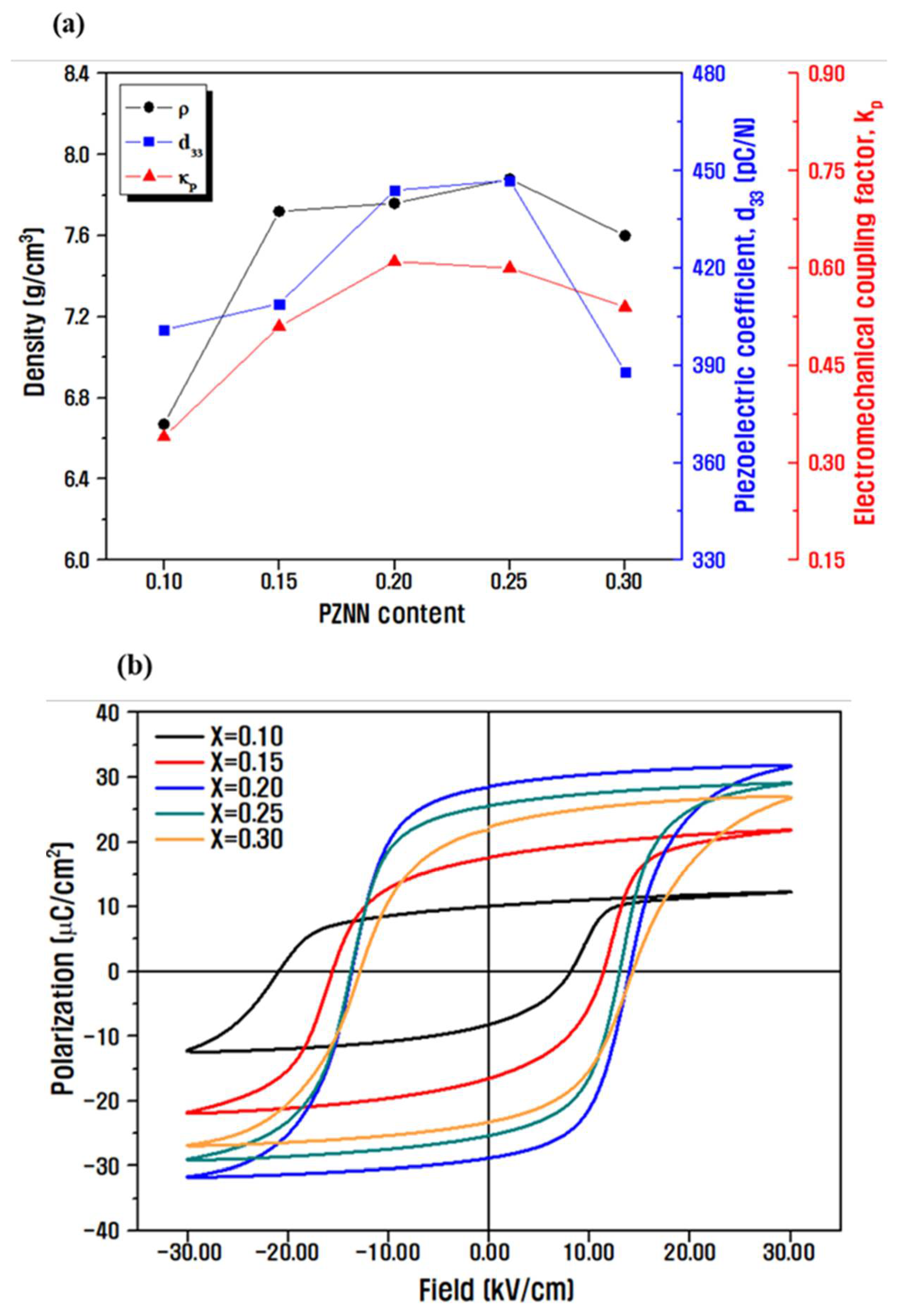
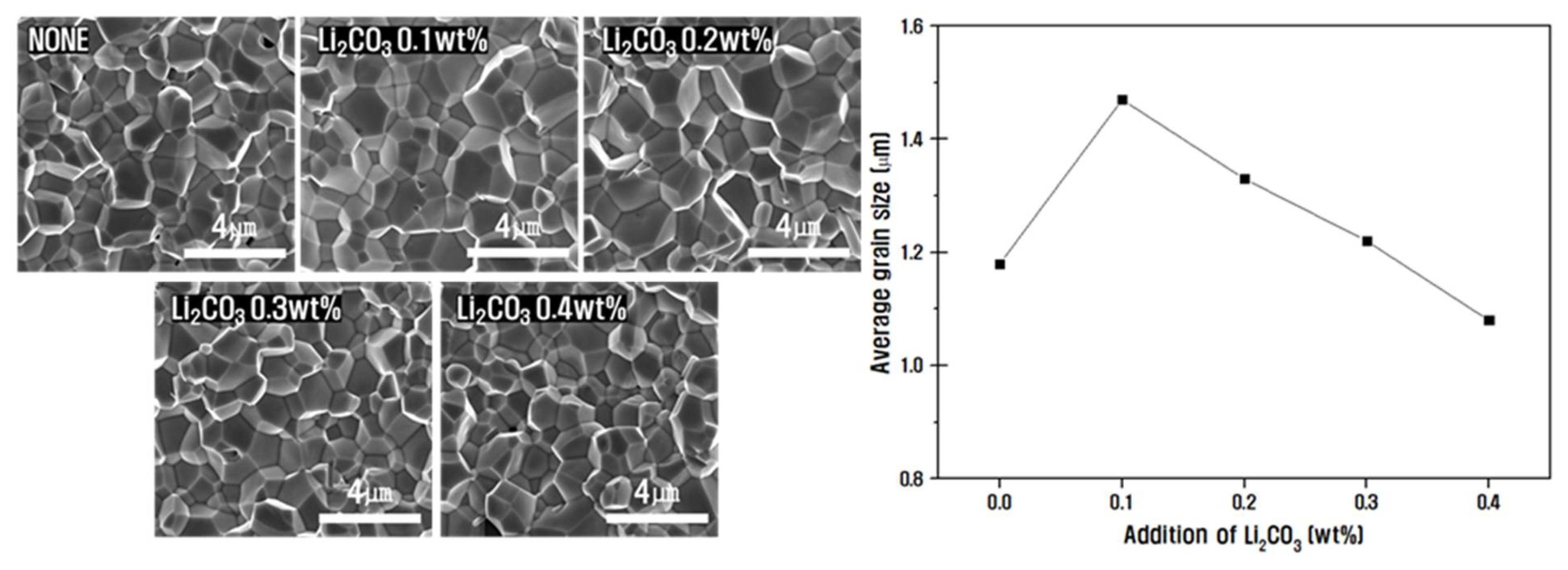

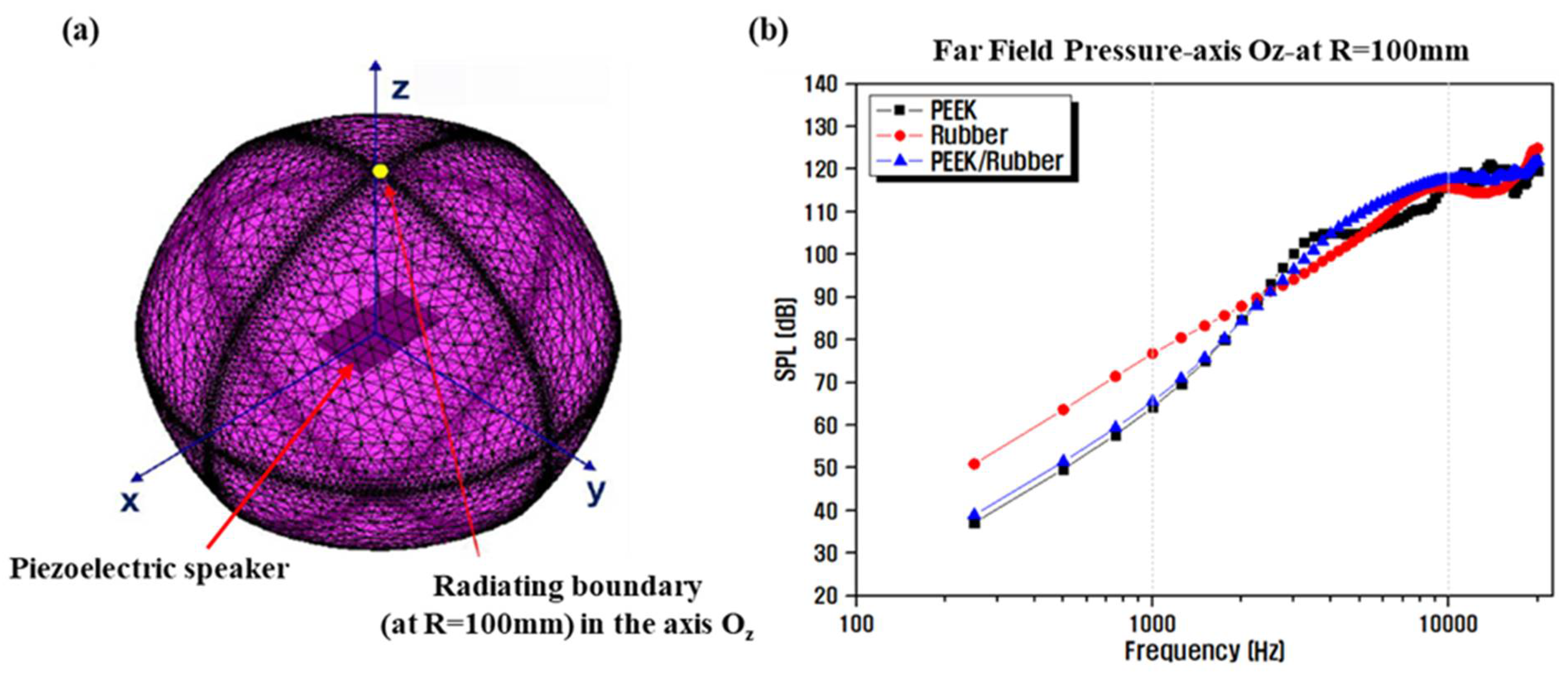
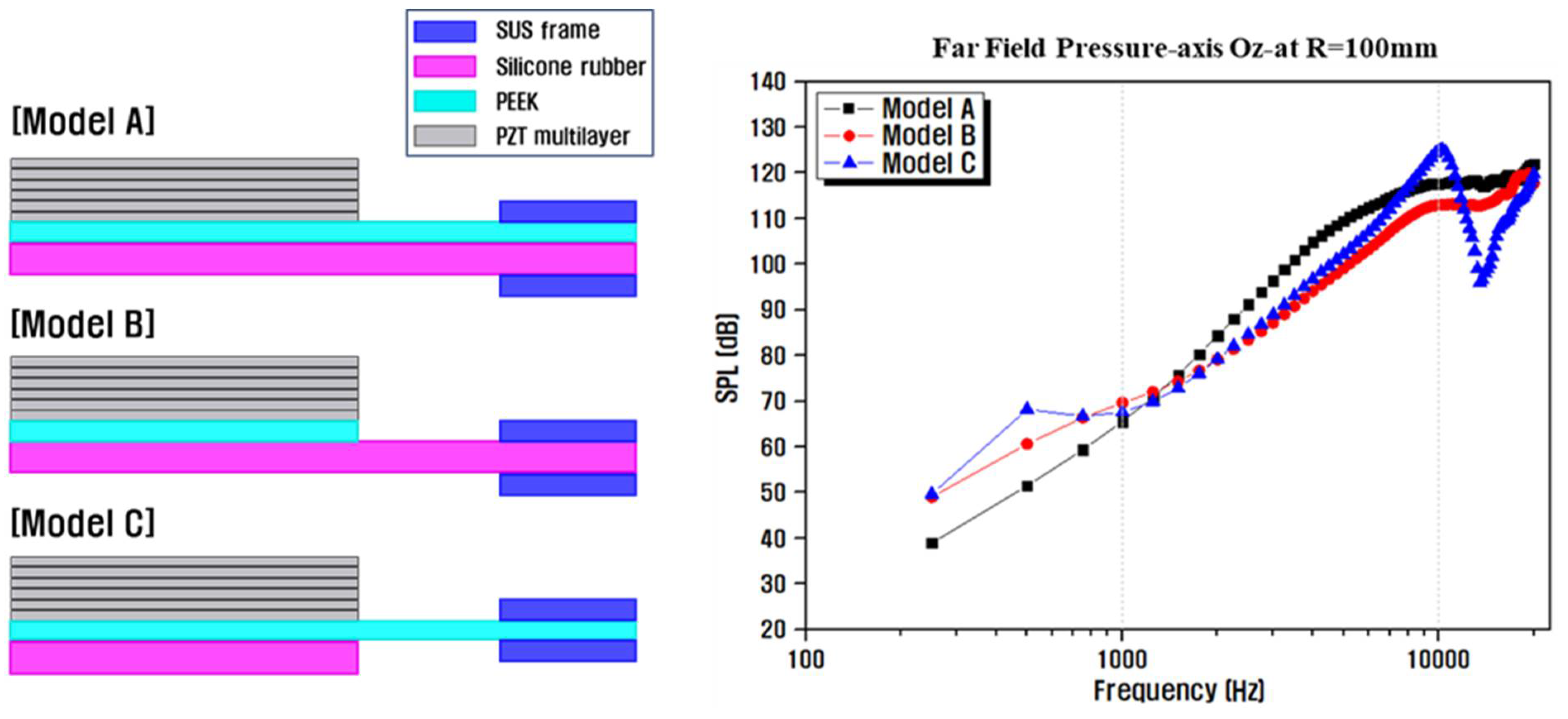
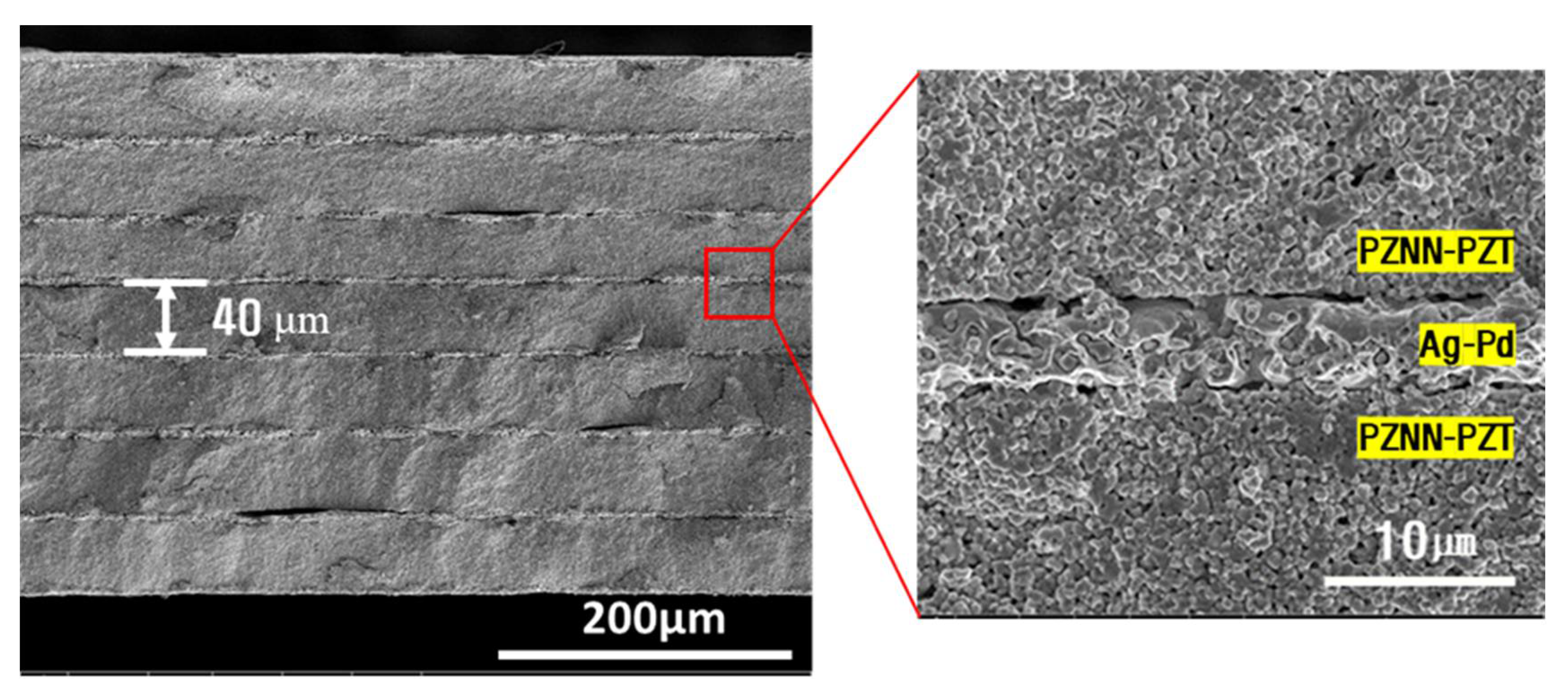
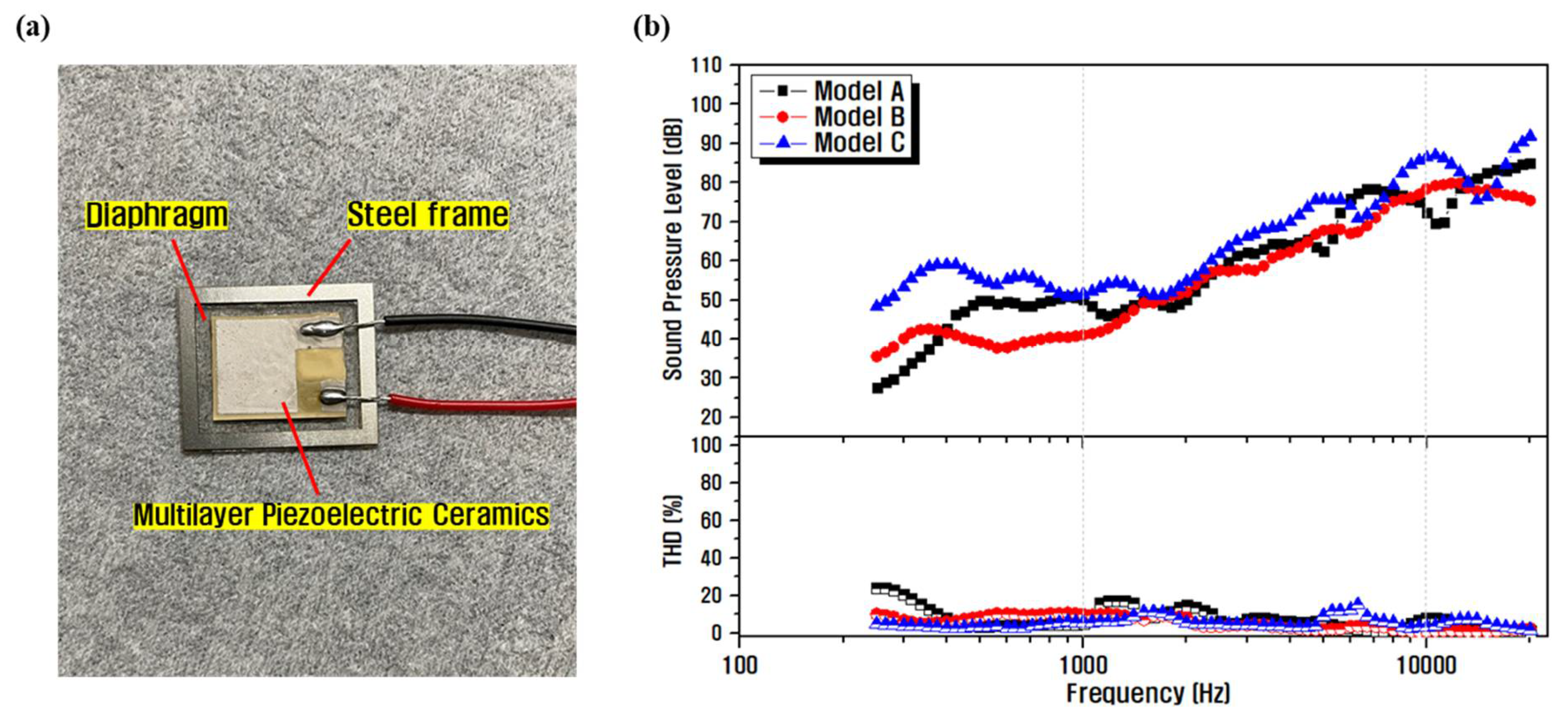
| Parameter | Conditions | |
|---|---|---|
| Geometry (mm) | Multilayer piezoelectric actuator | 12 × 16 × 0.32 |
| Silicone rubber | 0.1 | |
| PEEK | 0.05 | |
| Steel frame | 20 × 24 × 0.4 | |
| Definition | Input voltage (Vp) | 5 |
| Frequency range (Hz) | 250–20,000 | |
Publisher’s Note: MDPI stays neutral with regard to jurisdictional claims in published maps and institutional affiliations. |
© 2021 by the authors. Licensee MDPI, Basel, Switzerland. This article is an open access article distributed under the terms and conditions of the Creative Commons Attribution (CC BY) license (https://creativecommons.org/licenses/by/4.0/).
Share and Cite
Kim, S.; Lee, H. Piezoelectric Ceramics with High d33 Constants and Their Application to Film Speakers. Materials 2021, 14, 5795. https://doi.org/10.3390/ma14195795
Kim S, Lee H. Piezoelectric Ceramics with High d33 Constants and Their Application to Film Speakers. Materials. 2021; 14(19):5795. https://doi.org/10.3390/ma14195795
Chicago/Turabian StyleKim, Sowon, and Heechul Lee. 2021. "Piezoelectric Ceramics with High d33 Constants and Their Application to Film Speakers" Materials 14, no. 19: 5795. https://doi.org/10.3390/ma14195795







